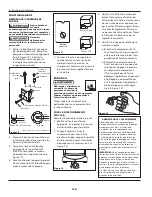
8
Operating Instructions
Troubleshooting Chart
Symptom
possible Cause(s)
Corrective Action
Low discharge pressure
1 . Air demand exceeds pump capacity
1 . Reduce air demand or use a compressor with more capacity .
2 . Restricted air intake
2 . Clean or replace the air filter element .
3 . Air leaks (fittings, tubing on
compressor, or plumbing outside of
system)
3 . Listen for escaping air . Apply soap solution to all fittings and
connections . Bubbles will appear at points of leakage . Tighten or
replace leaking fittings or connections . Use pipe thread sealant .
4 . Blown gaskets
4 . Replace any gaskets proven faulty on inspection .
5 . Leaking or damaged valves
5 . Remove head and inspect for valve breakage, misaligned valves,
damaged valve seats, etc . Replace defective parts and reassemble .
Install a new head gasket
each time the head is removed
Pump overheating causes
air filter to melt
1 . Insulating gasket between filter and
head is missing
1 . Install gasket .
2 . Broken valves/blown gasket
2 . Replace valves or install new gasket .
Excessive noise (knocking)
1 . Loose motor pulley or flywheel
1 . Tighten pulley / flywheel clamp bolts and set-screws .
2 . Loose fasteners on pump or motor
2 . Tighten fasteners
3 . Lack of oil in crankcase
3 . Check for proper oil level; if low, check for possible damage to
bearings . Dirty oil can cause excessive wear .
4 . Worn connecting rod
4 . Replace connecting rod . Maintain oil level and change oil more
frequently .
5 . Worn piston pin bores
5 . Remove piston assemblies from the compressor and inspect for
excess wear . Replace excessively worn piston pin or pistons, as
required . Maintain oil level and change oil more frequently .
6 . Piston hitting the valve plate
6 . Remove the compressor head and valve plate and inspect for
carbon deposits or other foreign matter on top of piston . Replace
head and valve plate using new gasket . See Lubrication section for
recommended oil .
7 . Noisy check valve in compressor
system
7 . Replace check valve .
Do not disassemble check
valve with air pressure in tank
Large quantity of oil in
the discharge air
nOTe:
In an oil lubricated
compressor there will
always be a small amount
of oil in the air stream .
1 . Worn piston rings
1 . Replace with new rings . Maintain oil level and change oil more
frequently .
2 . Compressor air intake restricted
2 . Clean or replace filter . Check for other restrictions in the intake
system .
3 . Excessive oil in compressor
3 . Drain down to full level .
4 . Wrong oil viscosity
4 . Use Mobil 1
®
10W-30 .
Water in discharge air /
tank
Normal operation . The amount of
water increases with humid weather
1 . Drain tank more often . At least daily .
2 . Add a filter to reduce the amount of water in the air line .
Motor hums and runs
slowly or not at all
1 . Low voltage
1 . Check incoming voltage . It should be approximately 230 volts .
Motor will not run properly on 208 volts . Low voltage could be
due to wires (from electrical source to compressor) being too small
in diameter and / or too long . Have a qualified electrician check
these conditions and make repairs as needed .
2 . Too many devices on same circuit
2 . Limit the circuit to the use of compressor only
3 . Loose electrical connections
3 . Check all electrical connections
4 . Malfunctioning pressure switch -
contacts will not close
4 . Replace pressure switch .
5 . Malfunctioning check valve
5 . Replace check valve .
Do not disassemble check
valve with air pressure in tank
6 . Defective unloader valve on
pressure switch
6 . Replace unloader valve
7 . Defective motor capacitor(s)
7 . Replace capacitor(s)
8 . Defective motor
8 . Replace motor
Summary of Contents for VT631402
Page 31: ...31 Notes Notas...









































